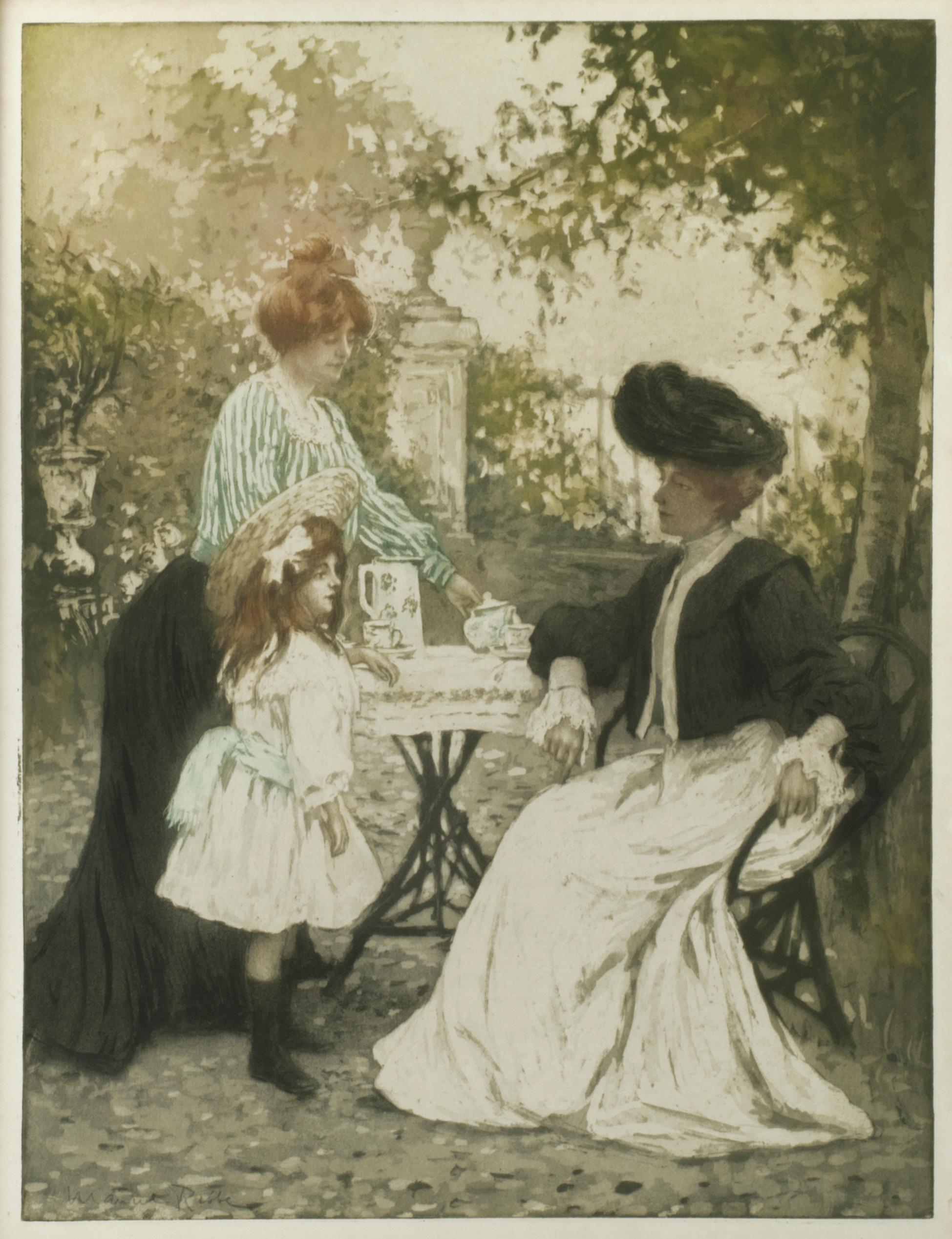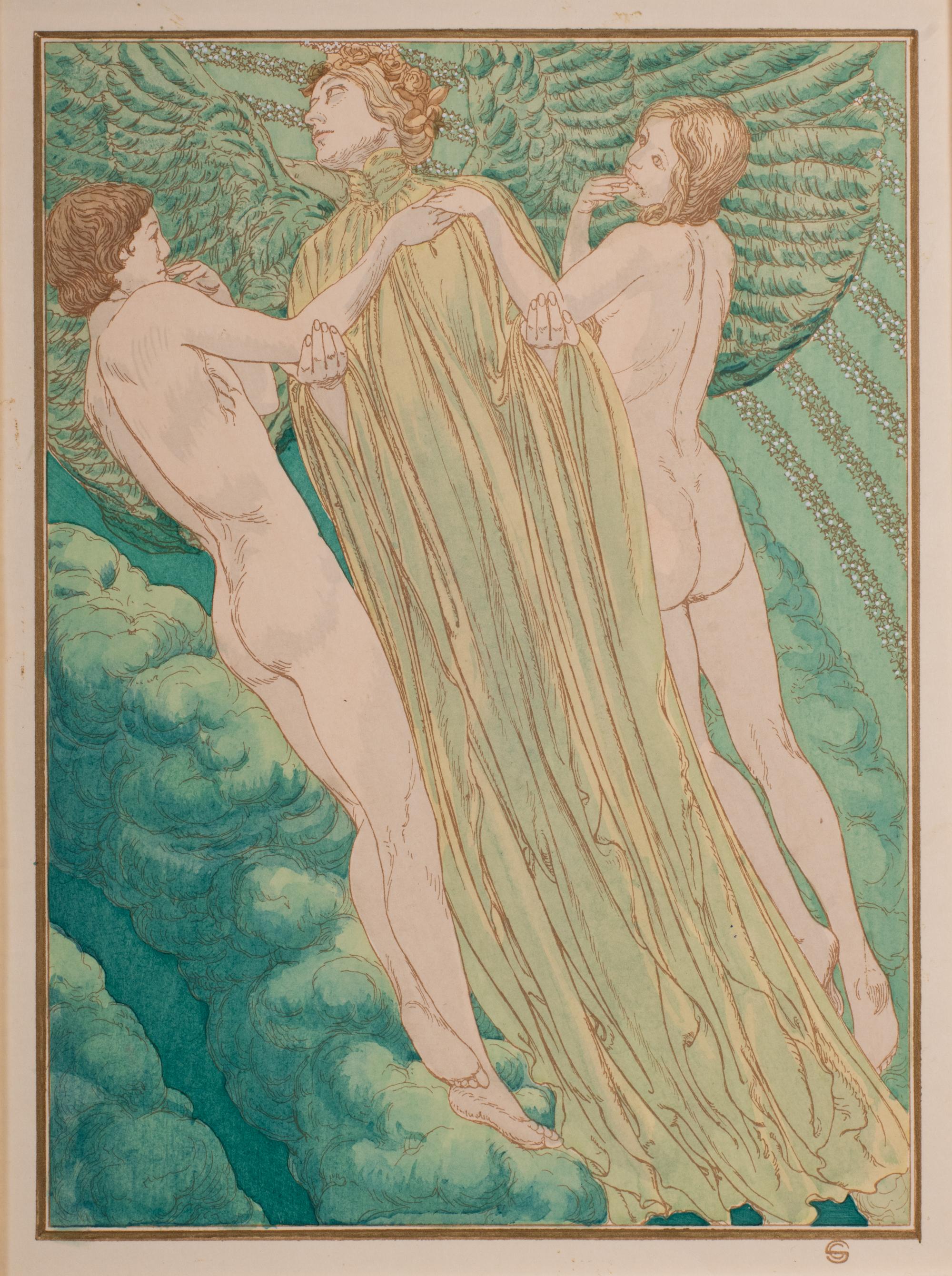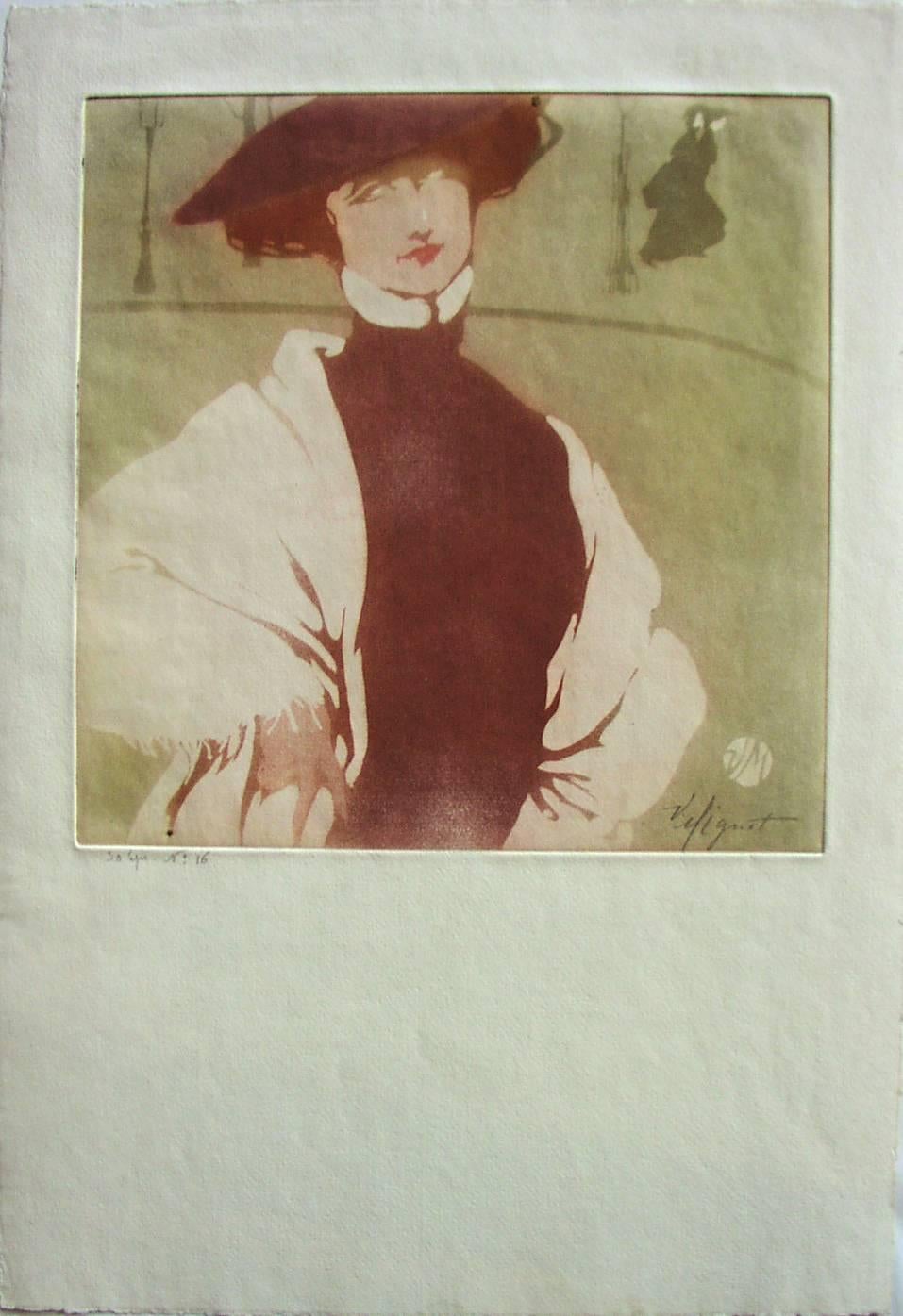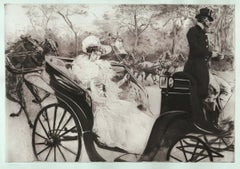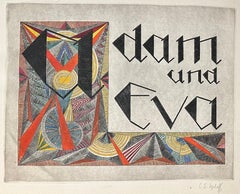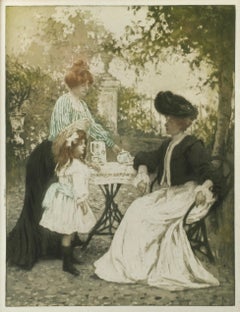
Le Tasse de The (The Cup of Tea)
View Similar Items
Want more images or videos?
Request additional images or videos from the seller
1 of 9
Manuel RobbeLe Tasse de The (The Cup of Tea)c. 1906
c. 1906
About the Item
- Creator:Manuel Robbe (1872 - 1936, French)
- Creation Year:c. 1906
- Dimensions:Height: 19.5 in (49.53 cm)Width: 15 in (38.1 cm)
- Medium:
- Movement & Style:
- Period:
- Condition:
- Gallery Location:Fairlawn, OH
- Reference Number:Seller: FA102801stDibs: LU1407629312
About the Seller
5.0
Recognized Seller
These prestigious sellers are industry leaders and represent the highest echelon for item quality and design.
Platinum Seller
These expertly vetted sellers are 1stDibs' most experienced sellers and are rated highest by our customers.
Established in 1978
1stDibs seller since 2013
Typical response time: 1 hour
Associations
International Fine Print Dealers Association
More From This SellerView All
- Le Tasse de The (The Cup of Tea)By Manuel RobbeLocated in Fairlawn, OHLe Tasse de The (The Cup of Tea) Color aquatint and etching, c. 1906 Signed in pencil in the image (see photo) Edition: c. 100 Reference: Merrill Chase, Volume 1, No. 85 Condition: F...Category
Early 1900s Art Nouveau Figurative Prints
MaterialsAquatint
- La PromenadeBy Edgar ChahineLocated in Fairlawn, OHLa Promenade Etching, soft-ground, aquatint & drypoint, Signed in pencil lower left Published by Edmund Sagot, Paris Edition of 50 in black only, aside from the edition of 50 in co...Category
Early 1900s Art Nouveau Figurative Prints
MaterialsDrypoint, Etching, Aquatint
- L'Aieule (The Grandmother)By Louis LegrandLocated in Fairlawn, OHL'Aieule (The Grandmother) Etching and aquatint printed in colors, 1904 Signed with the red stamp of the publisher, Gustave Pellet, Lugt 1193 and numbered (see photo) Edition: 100 (81/100) Reference: Arwas 202 iv/IV IFF 98 Condition: Excellent, the sheet aged as usual Image size: 14 1/4 x 18 5/8" Sheet size: 16 15/16 x 24 1/4" Louis Auguste Mathieu Legrand (29 September 1863 – 1951) was a French artist, known especially for his aquatint engravings, which were sometimes erotic. He was awarded the Légion d'honneur for his work in 1906. Life Legrand was born in the city of Dijon in the east of France. He worked as a bank clerk before deciding to study art part-time at Dijon's Ecole des Beaux-Arts. He won the Devosge prize at the school in 1883.[2] In 1884 Legrand studied engraving under the Belgian printmaker Félicien Rops. Legrand's artworks include etchings, graphic art and paintings. His paintings featured Parisian social life. Many were of prostitutes, dancers and bar scenes, which featured a sense of eroticism. According to the Hope Gallery, "Louis Legrand is simply one of France's finest early twentieth century masters of etching." His black and white etchings especially provide a sense of decadence; they have been compared to those of Henri de Toulouse-Lautrec, though his drawings of the Moulin Rouge, the can-can dance and the young women of Montmartre preceded Toulouse-Lautrec's paintings of similar scenes. He made over three hundred prints of the night life of Paris. They demonstrate "his remarkable powers of observation and are executed with great skill, delicacy, and an ironic sense of humor that pervades them all." Two of his satirical artworks caused him to be tried for obscenity. The first, "Prostitution" was a symbolic drawing which depicted a naked girl being grasped by a dark monster which had the face of an old woman and claws on its hands; the second, "Naturalism", showed the French novelist Émile Zola minutely studying the thighs of a woman with a magnifying glass. Defended by his friend the lawyer Eugène Rodrigues-Henriques (1853–1928), he was found not guilty in the lower court, but was convicted in the appeal court and then given a short prison sentence for refusing to pay his fine. Legrand was made famous by his colour illustrations for Gil Blas magazine's coverage of the can-can, with text by Rodrigues (who wrote under the pseudonym Erastene Ramiro). It was a tremendous success, with the exceptional quantity of 60,000 copies of the magazine being printed and instantly sold out in 1891. In 1892, at the instigation of the publishing house Dentu, Legrand made a set of etchings of his Gil Blas illustrations. The etchings were published in a book, Le Cours de Danse Fin de Siecle (The End of the Century Dance Classes). Legrand took a holiday in Brittany, which inspired him to engrave a set of fourteen lithographs of simple country life called Au Cap de la Chevre (On Goat Promontory). It was published by Gustave Pellet who became a close friend of Legrand's. Pellet eventually published a total of 300 etchings by Legrand, who was his first artist; he also published Toulouse-Lautrec and Félicien Rops among others. He did not only work in graphics; he exhibited paintings at the Paris salon of the Société Nationale des Beaux-Arts starting in 1902. In 1906 he was made a chevalier of the Légion d'honneur. Legrand died in obscurity in 1951. A retrospective exhibition was held at the Félicien Rops museum in Namur, Belgium in 2006 to celebrate his graphic art. The art collector Victor Arwas published a catalogue raisonné for the occasion. Books illustrated de Maupassant, Guy: Cinq Contes Parisiens, 1905. Poe, Edgar Alan: Quinze Histoires d'Edgar Poe...Category
Early 1900s Art Nouveau Figurative Prints
MaterialsAquatint
- Heureux age! (Happy Age!)By Victor MignotLocated in Fairlawn, OHHeureux age! (Happy Age!) Etching and aquatint. c, 1900 Signed lower right in pencil Edition; 50 (14/50) Published by Edmund Sagot, Paris Sagot blindstamp, Lugt 2254, lower right Con...Category
Early 1900s Art Nouveau Figurative Prints
MaterialsAquatint
- Danseuses s'habillant (Laurence adjusting her hair and Mignon adjusting clothesBy Louis LegrandLocated in Fairlawn, OHDanseuses s'habillant (Laurence adjusting her hair and Mignon adjusting hre clothes) Drypoint & aquatint, 1893 Signed in the plate (see photo) After the division of the plate into A. 81 (as here) and A. 82 Divant la glace Editon 100 printed on velin paper Issued by Pellet in the set, Les Petites du Ballet, Gustave Pellet editeur, 1893 (13 plates), second state (b) without remarque Reference: Arwas 81, top portion of the plate vii/VIII Plate/Image size: 6 x 8 7/16 inches Condition: excellent Louis Auguste Mathieu Legrand (29 September 1863 – 1951) was a French artist, known especially for his aquatint engravings, which were sometimes erotic. He was awarded the Légion d'honneur for his work in 1906. Life Legrand was born in the city of Dijon in the east of France. He worked as a bank clerk before deciding to study art part-time at Dijon's Ecole des Beaux-Arts. He won the Devosge prize at the school in 1883.[2] In 1884 Legrand studied engraving under the Belgian printmaker Félicien Rops. Legrand's artworks include etchings, graphic art and paintings. His paintings featured Parisian social life. Many were of prostitutes, dancers and bar scenes, which featured a sense of eroticism. According to the Hope Gallery, "Louis Legrand is simply one of France's finest early twentieth century masters of etching." His black and white etchings especially provide a sense of decadence; they have been compared to those of Henri de Toulouse-Lautrec, though his drawings of the Moulin Rouge, the can-can dance and the young women of Montmartre preceded Toulouse-Lautrec's paintings of similar scenes. He made over three hundred prints of the night life of Paris. They demonstrate "his remarkable powers of observation and are executed with great skill, delicacy, and an ironic sense of humor that pervades them all." Two of his satirical artworks caused him to be tried for obscenity. The first, "Prostitution" was a symbolic drawing which depicted a naked girl being grasped by a dark monster which had the face of an old woman and claws on its hands; the second, "Naturalism", showed the French novelist Émile Zola minutely studying the thighs of a woman with a magnifying glass. Defended by his friend the lawyer Eugène Rodrigues-Henriques (1853–1928), he was found not guilty in the lower court, but was convicted in the appeal court and then given a short prison sentence for refusing to pay his fine. Legrand was made famous by his colour illustrations for Gil Blas magazine's coverage of the can-can, with text by Rodrigues (who wrote under the pseudonym Erastene Ramiro). It was a tremendous success, with the exceptional quantity of 60,000 copies of the magazine being printed and instantly sold out in 1891. In 1892, at the instigation of the publishing house Dentu, Legrand made a set of etchings of his Gil Blas illustrations. The etchings were published in a book, Le Cours de Danse Fin de Siecle (The End of the Century Dance Classes). Legrand took a holiday in Brittany, which inspired him to engrave a set of fourteen lithographs of simple country life called Au Cap de la Chevre...Category
1890s Art Nouveau Figurative Prints
MaterialsAquatint
- L'Angellus (The Angel)By Alfredo MüllerLocated in Fairlawn, OHL'Angellus (The Angel) Etching, engraving and acquatint on Arches paper, 1908 Signed lower right by the artist (see photo) This is a first state impression printed in a brown/black ink There was also a color edition of 50 impressions published by Sagot Reference: Wurzer 27 Provenance: Edmund Sagot, the publisher Sagot Heirs Condition: Rich impression. Verso: print has staining. Printer's crease visibile from verso only. Image/Plate size: 19 1/4 x 15 1/2" (48.9 x 39.37 cm) Sheet size: 24 x 17 3/8 inches From the British Museum: "Colour etcher. Born in Livorno from a family of wealthy Swiss cotton merchants, studied with Giuseppe Ciaranfi and Michele Gordigiani in Florence. In 1886 exhibited with Fattori, Achille Lega and Tommasi in the Prima Esposizione delle Belle Arti in Livorno. In 1888 he and his family moved to Paris, where he studied first with François Flameng until 1892 and later with Carolus-Duran. Müller remained in the French capital until the outbreak of the First World War, taking French citizenship in 1913. He worked in the countryside at Barbizon, Suresnes and elsewhere, but also made frequent visits to his native country, where he exhibited regularly in Florence with the Promotrice Fiorentine. His early work was indebted to Fattori and Plinio Nomellini, but he soon became interested in the Impressionists and was credited by the critic Mario Tinti with introducing the luminism of Monet into Italian art. Müller was a member of the Société des Artistes Indépendents and exhibited regularly in the Paris dealer...Category
Early 1900s Art Nouveau Figurative Prints
MaterialsEtching
You May Also Like
- Dornröschen (Sleeping Beauty.)By Heinrich VogelerLocated in Storrs, CTReif 20.IIc(of e). 10 5/8 x 9 3/4 (sheet 19 X 12 3/4). Slight scattered foxing in the margins, away from the image. A rich, tonal impression printed on sturdy wove paper. Proof aside...Category
Late 19th Century Jugendstil Figurative Prints
MaterialsFiberglass, Drypoint, Etching, Aquatint
$1,200 Sale Price20% Off - Personages with LambsBy Sylvain SauvageLocated in San Francisco, CAThis artwork "Personages with Lambs" 1924 is an original colors aquatint by noted French artist Felix Roy A.K.A Sylvain Sauvage, 1888-1948. It is hand signed and numbered 88/350 in pencil by the artist. The image size is 13 x 9.5 inches, framed is 20 16 inches. Published and printed by La Societe Des Graveurs Modernes, Paris. Custom framed in a wooden gold frame. It is in excellent condition, especially considering the age of this artwork About the artist. Félix Roy, said Sylvain Sauvage (born in Baume-les-Messieurs ( Jura ) on May 8 , 1888 and died in Paris in January 1948 ) is an illustrator and technician of the French book. He was an exhibitor at the Salon des Artistes Décorateurs and Director of École Estienne . He illustrated many books of the French classic literature. The work of Sylvain Sauvage is held in numerous private collections in France and Europe. Selected books illustrated by the artist. L'Ingénue de Voltaire, Kieffer, 1922 La fille aux yeux d'or de Balzac, G. Crès, 1923 Monsieur Nicolas ou le cœur humain dévoilé. Mémoires intimes de Restif de la Bretonne, illustrés par Sylvain Sauvage de Restif de la Bretonne, Henri Jonquières, 1924 Les Belles Dames de Paris, historiettes de Tallemant de Réaux, coll. « Le livre du lettré », 1924 (avec une préface de Gérard Bauër) Anatole France, Les sept femmes de la Barbe Bleue et autres contes merveilleux, A.&G. Mornay, Paris, 1925 Marquis de Sade, Ernestine, Cabinet du Livre / Jean Fort Éditeur, Paris, 1926 : 10 eaux-fortes Casanova (J. de, Seigneur de Seingalt.), Une aventure de Casanova, Histoire complète de ses amours avec la belle C. C. et la religieuse de Muran. Compositions de Sylvain Sauvage gravées avec la collaboration de E. Feltesse. Paris, [chez l'artiste], 1926. Candide de Voltaire, chez l'Artiste (imprimé chez Frazier-Soye et Haasen), 1928 Les Dieux ont soif de Anatole France, Éditions du Nord, 1928 Le Bon Plaisir d’Henri de Régnier, La Roseraie, 1929 : 20 eaux-fortes en couleurs et vingt bois gravés La Troisième Jeunesse de madame Prune de Pierre Loti, Calmann-Levy, 1936 Les Romanesques ; Les Deux Pierrots ; La Dernière Nuit de Don Juan d’Edmond Rostand, éditions Pierre Laffitte, 1939 ; illustrations de Auguste Leroux...Category
Early 20th Century Art Nouveau Figurative Prints
MaterialsAquatint
- Adam and EvaLocated in Wilton, CTWith 15 (8 signed) coloured original etchings and aquatints by C. E. Uphoff. Original vellum with gilt cover vignette in private linen case with gilt title on spine (stained due to m...Category
1920s Art Nouveau Figurative Prints
MaterialsAquatint
- "Sublime Elevation" for Hésperus Art Nouveau Lithograph by Carlos SchwabeBy Carlos SchwabeLocated in Chicago, ILHand-colored Stone Lithograph on Japon; Aquatint.Category
Early 1900s Art Nouveau Figurative Prints
MaterialsAquatint, Lithograph
- "Angels" Illustration for Hésperus, Art Nouveau Lithograph by Carlos SchwabeBy Carlos SchwabeLocated in Chicago, ILHand-colored Stone Lithograph on Japon; Aquatint.Category
Early 1900s Art Nouveau Figurative Prints
MaterialsLithograph, Aquatint
- Color AquatintBy Victor MignotLocated in New York, NYCa. 1900. Original color aquatint. Very fine impression on cream laid Arches paper, signed in pencil lower right and numbered. No. 16 of 30 impressions. Full Margins. 17 1/2 x 12" Im...Category
Early 1900s Art Nouveau Figurative Prints
MaterialsAquatint
